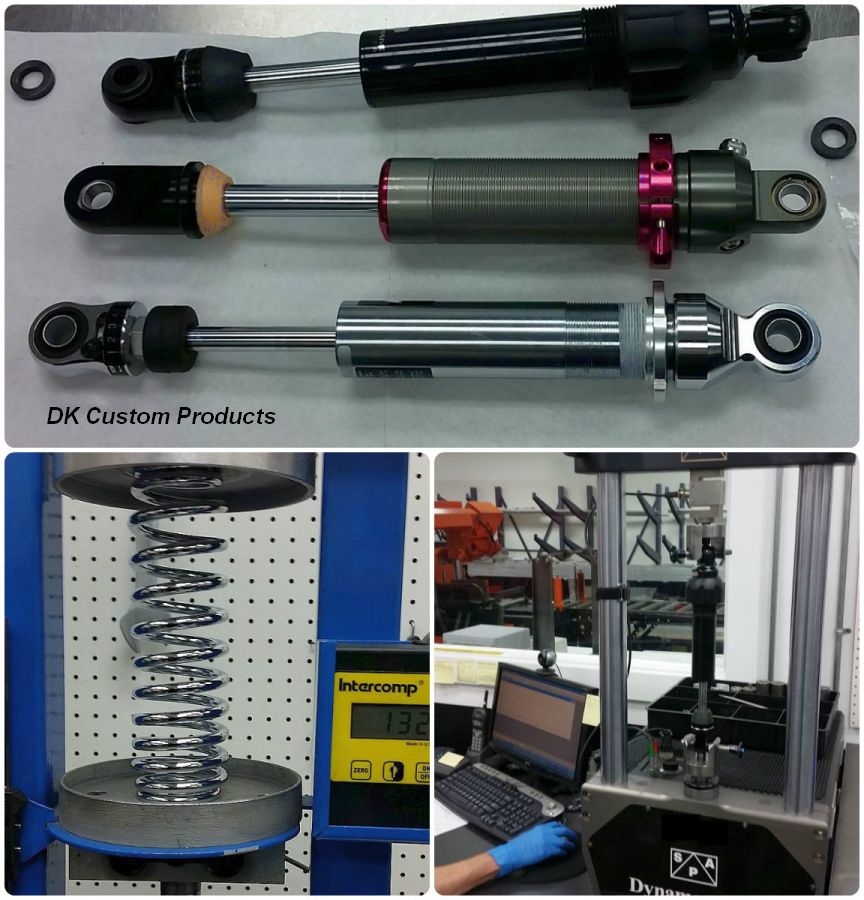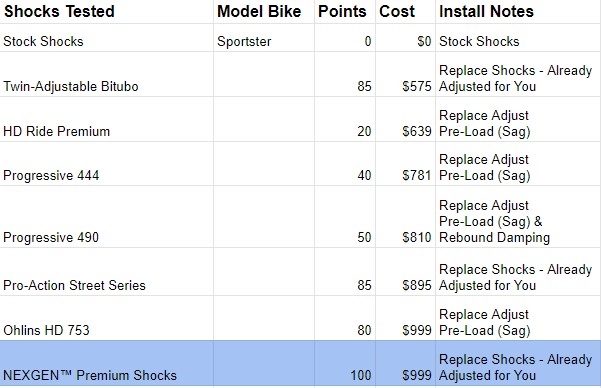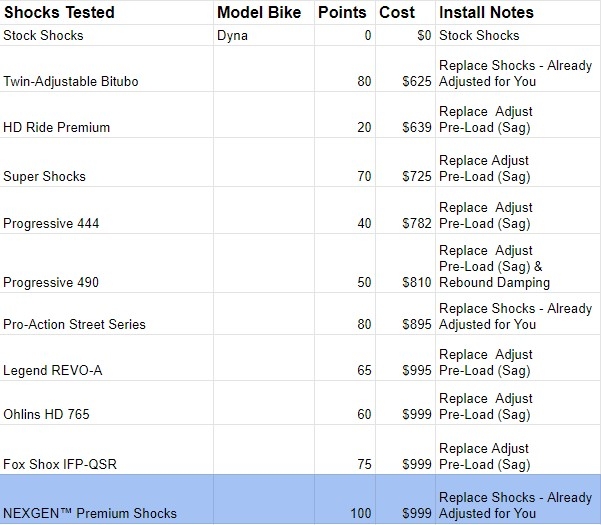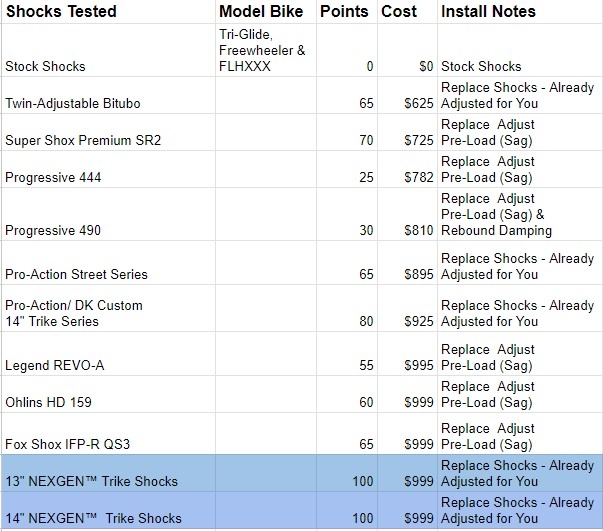Overview of Performance Rear Shocks
Rear Shocks Testing Report
Sportster-Dyna-Touring-Trike
How We Tested:
Everyone’s perception of what is a good ride can vary. So we employed the butts of more than a few folks.
This is our 3rd Update of the Rear Shocks Testing Report.
We have now spent over 6 years and more than 75,000 miles testing a wide array of rear shocks. We also spent time testing various shocks on a Shock Dynamometer, measuring compression, rebound, spring rates and travel.

We used 3 Sportsters, 2 Dynas, a Street Glide, an Electra-Glide, an Ultra, a Freewheeler and 3 Tri-Glides.
We ran solo, 2-up, & loaded down with luggage.
Our focus was on how it felt, and how it handled in a variety of situations-
We have two “courses” that we rode through, slowly, at cruising speed, and fast. We also did several longer trips, ranging from 800 miles to 3,000 miles, both 1 up and 2 up.
Another aspect of the testing is that when you go from one shock to another, you will notice some differences, but many times, when you go Back to the previous shock, you will pick up even more differences. Because of that, we tested each pair of shocks multiple times, before and after other shocks in the test.
Specific Ride Compliance Testing Strategies-
Riding two circuits, with straights, curves, smooth & bumpy surfaces. We rode thru the same curves & over the same bumps & dips under acceleration, cruising and braking conditions... 1 up, 2 up and loaded.
On 2 wheeled bikes we paid close attention to “wallowing”, and on the Trikes we paid close attention to body roll, testing for stability in curves. For us it is important to be able to go as fast thru a curve as you want without having wallow or body roll being a limiting factor. What this translates to, in daily riding, is better control/safer operation in the curves, even at normal speeds.
Another safety factor we tested for was rear tire/tires skidding when braking hard on roads that were not smooth. The better a shock functions, the better it stays in contact with the road, reducing the possibility of the rear tire/tires “locking up” when going over an imperfect surface. This is not particularly needed in everyday riding, but when it is time to do an emergency stop, it can make all the difference.
One of the most important things we looked for in our testing was to make the small road imperfection disappear and to take all the harsh jolts and "round the edges", making them seem more like a small dip.
What we Tested
We tested over 2 dozen different shocks, including all the popular brands/models. We tested 11’, 12’, 13”, 13.5 & 14” shocks.
To keep the report from being excessively large/confusing, we have not listed all the shocks we tested. What we have left off the report are some that produced less than favorable results, nor have we listed some of the products that were very expensive and produced results no better than significantly less expensive options.
We have included a few of the more popular model shocks to give a point of reference when comparing.
Test Results
In all our testing, the stock shocks were consistently the least favorable.
Point system-
In all our testing, the stock suspension was consistently the least favourable, and the NEXGEN™ were the most favorable. For grading we used the stock as a reference # of 0, and the NEXGEN™ as a reference # of 100.
Everything else was awarded points between 0-100, based on how much better they are than stock, and how close they are to the most favorable shocks.




In the Past to get 4" of Travel we had to use a 14" Shock. With the New Technology in the NexGen™ Trike Series Shocks™ we can now achieve 4" of Travel with the 13" shocks.
We could make the 14" shocks have even more travel, However, the frame of the Harley Trike will not allow for more than 4" of Travel in the rear suspension.
On The NexGen™ Trike Series Shocks™, both the 13" and 14" provide the same quality ride, with the same 4" of travel.
On the question of: Which should I get, 13" or 14"?
Answer:
2009-2013 HD Trikes, the preferred installation are the NexGen™ 14" with the Convertible Comfort Mount. They will also fit with the factory brackets. (They will Not fit with other companies lift kits)
2014-2016 HD Trikes the NexGen™14" Shocks will barely fit without the 14" Convertible Comfort Mount™ on some Trikes. We cannot say which ones...Harley manufacturing tolerances vary and some are just too tight to fit without the lift. They ALL fit with the Lift, and will ride even better with the Lift.
2017-Up HD Trikes, the preferred installation are the NexGen™ 13" Shocks with the Convertible Comfort Mount™
Important Note Regarding all the shocks we tested, but did not list in our charts: Many were so poor in ride quality and/or handling, there was no reason to clutter the chart with them.
*All prices listed in the chart are MSRP as of this report.
Some Rear Shock Suspension Basics
Springs are to keep the bike at the desired height when sitting still, and to control (partially) the amount of compression when hitting a bump.
Sag- How much the bike shocks settle (sag) when you sit on it.
Why proper sag is important-
Example of what can happen when there is not enough sag- After the wheel passes over a bump, it can lose contact with the road for an instant...this is because there is not enough rebound length for the shock to extend back down, enabling the tire to stay in contact with the road.
This is not such a big deal when going straight, however, if in a corner when a bump is hit, it can be disconcerting to feel the rear tire/tires “skip” & then “catch”. If you’ve ever felt that, you know what I mean.
If there is too much sag, then too much of the travel is used just by the weight of the bike and rider, leaving you with too little travel when riding, resulting in easily bottoming out.
Every shock we tested had a pre-load adjuster, which enable for easy adjustment of Sag. On the NEXGEN™, Bitubo and Pro-Action shocks these are adjusted for you, based on your weight, prior to you receiving them, meaning a little less work for you when you receive them. However, it can still be adjusted if the need arises.
Compression damping is what determines how fast or slow the shocks compress when the wheel encounters a bump.
Too fast and the travel gets eaten up quickly, causing bottoming out on larger bumps. To slow and it makes for a bumpy, or jolting ride.
What sets the NEXGEN™ apart is that there are separate circuits for compression and rebound damping. This allows the Compression Damping to be dialed in to the ideal, rather than being a compromise, as it is on other shocks.
Rebound damping is what determines how fast or slow the shocks return to “neutral” after the wheel passes over a bump.
Too fast and you have a bumpy/bouncy ride, too slow and you can lose tire/road contact.
Some of the shocks we tested have rebound damping adjustment, allowing for fine-tuning of the damping in the shocks.
One of the reasons the NEXGEN™ outperformed all the others is due to them having IAS inside, providing dynamically adjusting rebound damping.
Proper sag and damping keeps the shocks riding in the upper mid range of their travel, providing a comfortable ride, a stable & controlled ride, and more clearance (lean angle) in the curves.
Shock Technology-
There are 3 different designs used in shocks:
Emulsion- This is when the fluid and nitrogen are in the same chamber.
Internal Reservoir- This when the fluid and nitrogen are separated into their own internal chambers inside the shock.
External Reservoir- This is when extra fluid and/or nitrogen are contained.
External Reservoir shocks are used to keep the fluid cool in motocross bikes and racing bikes that see much more shock action than 99.9% of Harleys being ridden.
An internal reservoir shock is traditionally viewed as a superior design to the emulsion design in shocks, providing a better ride.
About half the shocks we tested were Emulsion and half Internal Reservoir design, & even with aggressive riding, we did not notice any fading of the Emulsion shocks we tested.
Link to More Photo's & Details on Performance Shocks
Link to Video Report of Shock Testing
Live Free - Ride Free!







